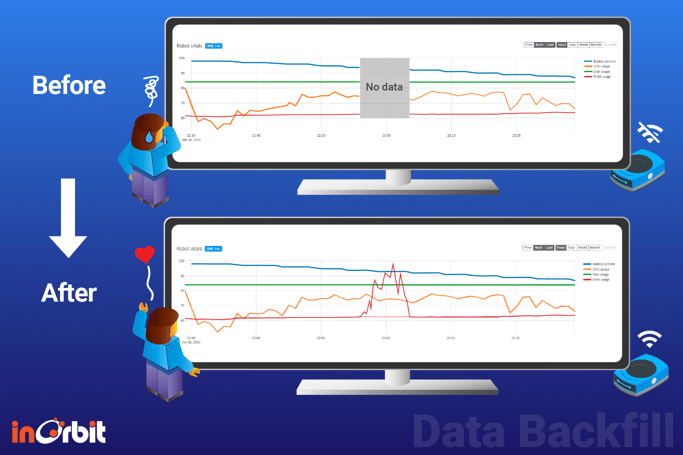InOrbit releases Data Backfill saving robot data once thought lost
Today InOrbit announces the release of Data Backfill, adding to our growing list of RobOps tools designed to address specific challenges companies face when managing robot fleets at scale. This is another piece of the puzzle for how to maintain end-to-end observability under even the most demanding conditions, eliminating gaps in collected data by reconstructing a robot’s operating history through offline data saved and backfilled upon reconnection.
In the development lab with a stable network connection (even Ethernet) and a robot staying relatively still, engineers usually don’t need to worry about how much data they can send from a robot to a laptop, or when they can do it. There is likely little worry about connectivity or how much data a robot generates and records for future analysis. But when that robot leaves the safe and controlled environment of the lab to be tested in the field or be used in production, network stability and resource allocation become incredibly important. When a connection is lost critical robot data often goes missing, which can be the difference between a successful deployment and a failed pilot.
An adaptable solution
Robots are huge data generators, sometimes producing gigabytes per minute. Camera images, laser scans, maps, temperature sensors and wheel odometry are just a few examples of the mountains of information created every second a robot operates. Whether engineers use a centralized cloud-data service or connect locally to robots for debugging, the amount of information robot teams need to access may be prohibitive for the connection type available. Along with expensive data rates, LTE and 5G often have poor quality and only intermittent connections, especially in indoor locations. A Wi-Fi deployment may improve coverage, yet robots can still encounter connection issues in dead zones, limiting connectivity. To address these issues, the InOrbit platform is built on a foundation of adaptability.
At InOrbit we practice aggressive data decimation for our users. Keeping data management costs under control while maintaining data quality and integrity is an important part of our approach to effective data management. Adaptive Diagnostics™ collect and transmit only the minimum information necessary for useful insights, and change dynamically depending on a robot's specific circumstances. This gives InOrbit the ability to throttle data up or down, adapting as needed for the situation. But there are circumstances every operator faces where they need even more support.
Data Backfill is designed to support robots, incident analysis, and reporting under different network and operational conditions – even if a robot is operating completely offline. There will be times when even the most stable network will be irregular or offline, just as there will be times when a robot will have a strong connection but may be performing resource-intensive tasks that require additional allocations (such as completing a mission). At other times, a robot will be idle and may have a better connection, such as when it is docked and recharging. Data Backfill provides a straightforward solution to these real-world challenges by capturing data offline on the robot and uploading it to the cloud when the conditions allow it.
This presents an interesting opportunity for robot data transmission to be turned off temporarily and then turned back on later when it may be a more optimal time to transmit.
Ensuring data integrity
InOrbit Data Backfill ensures data integrity and persistence. After a temporary network outage, such as when a robot is in a low/no signal zone, Data Backfill will reconstruct a robot’s operating history, filling in any gaps created while disconnected.
Sometimes, as part of carrying out a task or mission, an autonomous mobile robot may move into an area with limited or no Wi-Fi connection. Typically robots will continue to operate without a connection. While the robot may be disconnected from the InOrbit Cloud and other applications requiring connectivity, the InOrbit Agent will continue to run on the robot, collecting available data and storing it locally for future uploading once the robot reconnects.
Information saved by InOrbit Data Backfill can mean the difference between insightful data analysis and confusing information gaps that render all of your data useless.

Last year InOrbit launched Time Capsule, advanced functionality that lets robot operators and engineers “turn back time” to understand where robot failures occurred and optimize fleet efficiency. Comprehensive root-cause analysis is critical to resolving ongoing autonomy exceptions. Using Time Capsule along with the power of Data Backfill, robot operators and roboticists have unparalleled insight into robot data under even the most challenging of circumstances.
Strong RobOps starts with observability: beyond mere monitoring, it enables an understanding of the robot’s internal states from its external outputs. Data Backfill provides roboticists and operators with peace of mind, knowing that even under less-than-perfect circumstances their robots and their data are available. Contact the InOrbit team for any help needed with configuration or more details on Data Backfill.
Get started for free with InOrbit today, confident in your robot’s data integrity.